The Friends of the Wildflower Garden, Inc.
Plants of the Eloise Butler Wildflower Garden
The oldest public wildflower garden in the United States

Common Name
Common Mullein (Great Mullein, Flannel Plant, Candlewick Plant, Hag's Taper, Velvet Dock, Velvet Plant, Clown's Lung-wort, Torches, Our Lady's Flannel, Jacob's Staff, Aaron's Rod and at least 21 other names.)
Scientific Name
Verbascum thapsus L.
Plant Family
Figwort (Scrophulariaceae)
Garden Location
Upland
Prime Season
Early to Late Summer Flowering
Common Mullein is a non-native plant with a long distinguished history (see the Lore section at page bottom) that yet attaches scant respect. It is doubtful that anyone actually plants it in their garden but hopefully a few would let it grow when it shows up. The plant tends to show up all over as it is most happy to colonize roadsides and disturbed soil where a grouping of plants can make a stately impression. It is biennial and grows from a basal rosette that sends up the flower spike the second year. If the rosette is not formed early in the growing season, the young plant may not survive the winter.
The tall erect stem, up to 6 or 8 feet high, is hard to miss and the prior season stem will persist well into the summer as the stems are very rigid. It doesn't help its reputation that it is a coarse plant, with woolly stems and leaves.
The alternate, oblong leaves are quite soft (velvety) and the lower ones up to 12 inches long, rarely with any teeth. Leaves taper in size in a gradual arrangement until the inflorescence is reached. The uppers are stalkless, the lower leaves stalked. The lower leaves will be more ovate than oblong. The undersides have hooked hairs. The leaves spiral up the stem such that the shorter upper leaves shed water onto subsequent lower leaves - all to direct the water to the roots.
The inflorescence is a densely packed spike at the top of the stem above the leaves. Occasionally additional flower spikes may develop from the upper leaf axils. Flowers overlap in clusters of 2 to 7. The spike is densely hairy.
Flowers: The 5-part flowers appear to open from the bottom upward in several spiral rows, in fact, each flower is only open for one day, then the one above opens. The yellow corolla lobes are rounded and spreading and can be up to an inch across. The five stamens have yellow filaments, orange anthers and alternate with the corolla lobes; two of the five stamens are slightly longer than the others; these are placed lower in the calyx with the 3 shorter stamens above, the arrangement such that all 5 anthers are at about equal level in the corolla throat. The 2-locular ovary and style are green with a knob-like head on the style. There are some fine yellow or whitish hair at the base of the style and on the 3 upper filaments, the lower placed two being glabrous. The female parts mature first, but if a bee does not pollinate the flower before it closes for the day, it is capable of self-pollination. The outer calyx is 5-lobed and woolly.
Seed: Fertile flowers produce a two-celled ovoid hairy capsule, 7 to 10 mm long, that contains 100+ 4-angled ridged small seeds. Each average plant has 100+ capsules. These capsules can remain on the plant over winter. Seeds can be shaken or blown out of the capsule by the wind. Seeds remain viable for years if not decades.
Subspecies: There are 3 world wide, but only one in North America - subsp. thapsus.
Habitat: Mullein grows in disturbed areas in all kinds of soils, mesic to dry conditions, but with full sun. Roadcuts and roadsides and under used pastures are common places to see it. It has a taproot and spreads by reseeding.
Names: The genus Verbascum is from, and a corruption of, the Latin name for the plant, Barbascum and the species thapsus is probably after Thapsus in ancient Africa. The common name Mullein comes from the Latin "mollis", meaning "soft". The author name 'L.' is for Carl Linnaeus (1707-1778), Swedish botanist and the developer of the binomial nomenclature of modern taxonomy. As to the basis for the other common names see the Lore section below the photo section.
Comparisons: It is unlikely you will find another plant in our area to confuse with this one. While there are 5 other species of Verbascum once reported in Minnesota, they have not been seen in years and the DNR does not track any of them on the 2019 county census.

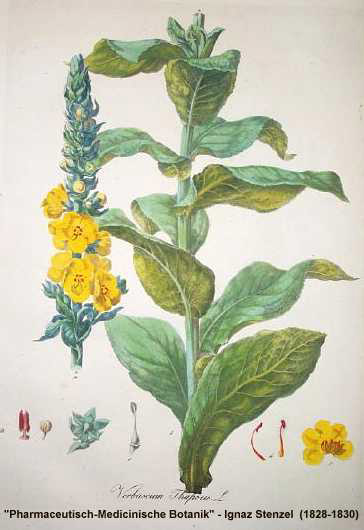
Above: The leaves of Mullein are arranged in spiral with shorter upper leaves shedding water onto the progressively larger leaves at the base of the plant.
Below: The flower spike elongates as the growing season progresses. Occasionally (3rd photo) you can fine a plant that develops multiple spikes from the top of the stem.
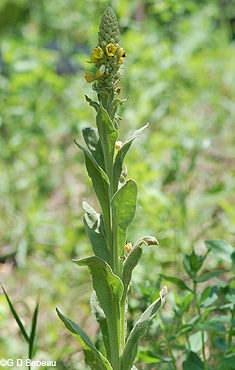


Below: 1st photo - The fine hooked hair on the underside of the leaf which was found useful in colonial times as explained below. 2nd photo - The basal 1st year rosette.


Below: 1st photo - Two lower stamens are without hair and longer than the other 3 place above them which have fine hair on their filaments. All 5 anthers are approximately at the same level. 2nd photo - The green calyx lobes are pointed and very hairy. The green style has knob-like tip.
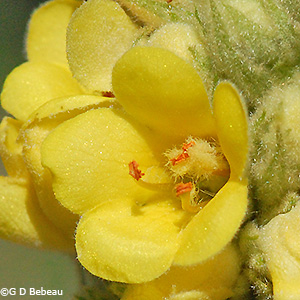
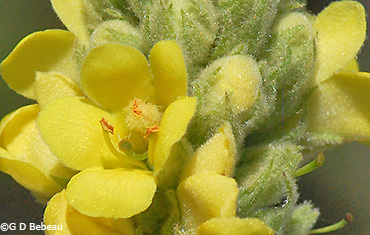
Below: Each average plant has 100+ seed capsules, each of which contains over 100 seeds. Note that the persistent calyx lobes on the capsule retain the hair.

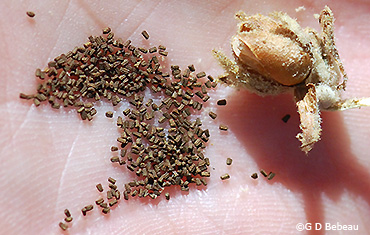

Notes: Common Mullein has long been in the Garden area. Eloise Butler catalogued it in her index file of plants in the early Garden on Sept. 5, 1908. Then on Oct. 21, 1910 she brought in a plant she named "Aaron's Rod". That name is used for several plants including Live-forever, Hylotelephium telephium. Since her 1910 source was Glenwood Springs, right near the Garden, we believe her 1910 plant was Mullein. Mullein was listed on Martha Crone's 1951 inventory of plants in the Garden at that time. The plant is not native to the United States, but an import with the pioneers. It is now found throughout North America except the farthest north Canadian provinces. It is considered a noxious weed in some states. There are over 350 species of Verbascum world-wide.
Naturalist Edwin Way Teale notes: "...I made a careful census of the little hibernators in such a plant, I know that between these leaves, as between a stack of woolen blankets, tiny forms of life - minute spiders and beetles and springtails - have found a snug winter retreat. There they will be secure while ice and snow lock in the winter fields. So far as I have observed, not one of our birds has shown any awareness of this convenient source of winter food." [from A Naturalist Buys an Old Farm.]
Toxicity: Nothing to fear - the entire plant contains slightly narcotic properties, however the short hooks on the stem and leaf hair can be a problem if precautions are not taken but they have been used on purpose for cosmetics- see 'lore' below.
Lore and Uses: Practical: Dried flower spikes, dipped in suet or tallow made torches - as far back as Roman times. The Greeks and others later used the leaves as lamp wicks, as the down on the leaves, when dry, was excellent tinder. Prior to the introduction of cotton for wicks, this was a substitute - hence the common name "Candlewick Plant." Another name is “Hag’s Taper” referring to a superstition that witches used it for illumination in their incantations. Quaker ladies who could not use cosmetics were said to rub the leaves on their cheeks to make them red, resembling rouge. The effect would last for a while, however it unfortunately was a reddening caused by the irritation of the skin from the barbed hairs on the leaves. A permanent green dye can be obtained from the leaves by extracting the pigment and adding sulfuric acid - not exactly a home recipe.
Monet grew V. thapsus in his large garden at Giverny. (Ref. 36A). He particularly liked mixing the ordinary with the exotic and had the plant growing near his Clematis frames and in contrast to the heavy oriental poppies - a combination still presented at Giverny. He let them self-seed and grow where they fell.
Lore and Uses: Medicinal: The leaves and flowers are used for medicinal purposes. The leaves - contain a large concentration of mucilage that can make a demulcent - a substance that softens mucous membranes - and have emollient and astringent properties. Decoctions and infusions were used to allay coughs, particularly the hacking cough of consumption; to remove the pain of hemorrhoids; and in treating diarrhea's.
The flowers contain gum, a resin, a glucoside, phosphoric acid and a volatile oil. An infusion of the flowers was a remedy for catarrhs, colic, etc. An oil was produced from the flowers and Mullein oil was used for earache and discharge from the ear. Hutchins (Ref. #12) reports an old German remedy for deafness as a result of dried earwax, wax too soft or insufficient wax: "Mullein oil, sun distilled from Green Mullein flowers, 3 to 5 drops twice a day until the condition is corrected." Mullein oil was considered a destroyer of disease germs. The fresh flowers steeped for 21 days in olive oil were said to make a bactericide. Extracts of Mullein show strong anti-inflammatory activity in lab tests.
The plant was listed in the 4th edition of the National Formulary. In Europe dried leaves were smoked in ordinary pipes to relieve irritation of mucus membranes. The Choctaw Indians of North American reportedly used it similarly. Mullein Tea was also made, but like any other use of the leaves in a liquid, it must be strained to remove any of the leaf hair that may be in the liquid as the barbs on the end of the hair would be extremely irritating if ingested. The common name "Bullock's Lungwort" refers to a long history of the plant being used by stockmen in treating respiratory diseases of cattle. The use of the word 'Clown', such as used here with 'Clown's Lung-wort' is from the English view that uneducated people using a herb for home remedies are into 'clown-ish' activities.
The most complete report of the uses of this plant can be found in the book by the English Herbalist Mrs. M. Grieve (Ref. #7). Densmore (Ref. #5) has no report of its use in Minnesota, perhaps because of its late introduction to the State.
Return to -- Site Plan/Archive Index --or-- List of Common Plant Names -- or -- List of Scientific Names -- or --Home Page - - - Back to top.
References: Plant characteristics are generally from sources 1A, 32, W2, W3, W7 & W8 plus others as specifically applied. Distribution principally from W1, W2 and 28C. Planting history generally from 1, 4 & 4a. Other sources by specific reference. See Reference List for details.
 Identification booklet for most of the flowering forbs and small flowering shrubs of the Eloise Butler Wildflower Garden. Details Here.
Identification booklet for most of the flowering forbs and small flowering shrubs of the Eloise Butler Wildflower Garden. Details Here.
©2013
Friends of the Wildflower Garden, Inc. Text and photos are by G. D. Bebeau unless otherwise credited. "www.friendsofeloisebutler.org"
071021